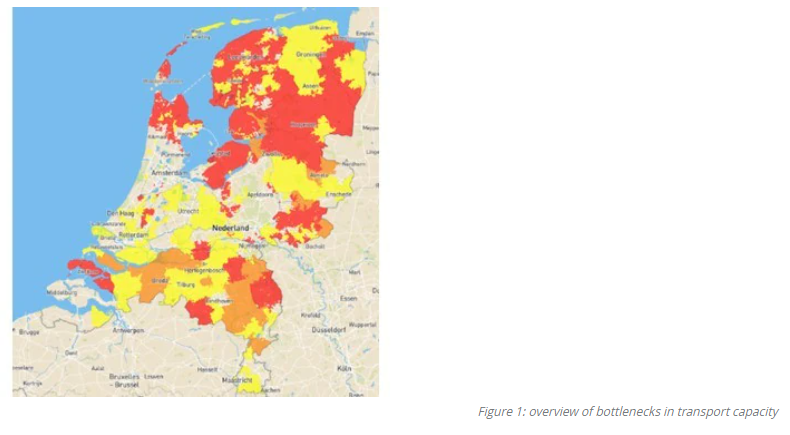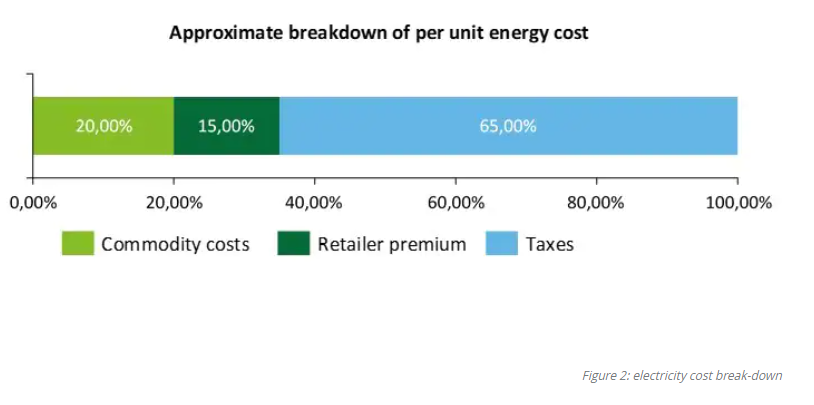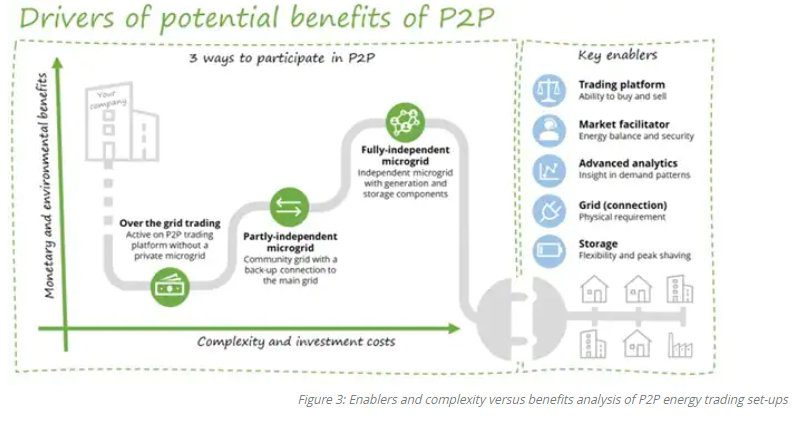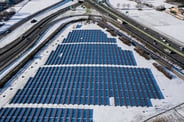Accelerating the energy transition and capturing business value with AI and data
The energy transition needs to accelerate but there are challenges that suggest we need to rethink our energy system. Until recently, the state of technology combined with the complexity of managing a reliable electricity network required a centralized system. We believe that we need a paradigm shift and that the stars have aligned.
On the one hand, there is a unique opportunity caused by the convergence of several technologies: smart meter deployment, blockchain technology, Peer to Peer and social platforms and advancements in artificial intelligence. On the other hand there is inadequate adoption of distributed renewable energy, increasing challenges for the complex role of the Transmission System Operator (TSO) and Distribution System Operators (DSOs) of managing the grid (fig 1), and a need for more resiliency to external shocks as witnessed in prices in the Fall of October 2021.

In the traditional centralized energy system, electricity is almost entirely centrally generated and co-located in the proximity of industrial sites. This is for good reason, to match production and consumption as much as possible and therefore optimize the transport across the network. From central production sites, a vast capillary network extends that transports electricity over hundreds of kilometers to smaller consumers. Consumers have access to the liberalized market strictly through eligible counterparts. Finally the electricity network is maintained as mentioned earlier by the TSO and the DSOs.
The challenge to this traditional model is coming from several developments that are not adequately addressed by the system’s original design. One important example of such developments is the increasing need for electricity in consumer’s everyday life, such as electrification of mobility, which increases demand in the periphery of the system. Another important example of the latest developments is increasing decentralized and intermittent renewable electricity generation, which creates a reverse flow of distributed energy generation [5]. The current system is struggling to deal with these developments and this leads to higher energy bills, increased investment costs, and more complex challenges for the DSOs and TSO.
We believe that Peer to Peer (P2P) energy trading has the potential to be one of the key catalysts for change and transformation towards the future of the electricity market, system and infrastructure. As we have seen in other industries, it is likely that consumers will push for the disruption that will follow and impact the business models of Energy Retailers and grid operators as well as government regulation and policy. Consumers, commercial and industrial businesses are the main focus of this discussion. Energy Retailers and Grid Operators are discussed more indirectly. We will also discuss what we believe consumers and businesses can do to prepare and how Deloitte can help set out on the journey with the right AI and Data capabilities.
P2P energy trading: what is it and different set-ups
To present how P2P energy trading works and its interaction in the current energy system, it is necessary to highlight the vital role that Balance Responsible Parties (BRP) play in ensuring a safe power supply. A key part of the challenge of safe and reliable grid operations comes from the fact that the amount of electricity taken off the grid for consumption, and the amount of electricity being put on the grid by electricity generation assets need to match almost perfectly at all times. Power outages will occur if the amount of electricity demanded diverges outside of a narrow tolerance bandwidth from the amount of electricity supplied. That’s why BRPs are responsible for forecasting and matching, every day, at 15 minute intervals how much electricity their clients will take from the grid, and how much electricity will be put on the grid by the assets they, or their clients hold.
As mentioned earlier, consumers have access to the market through eligible counterparts: Energy Retailers. The Energy Retailers charge a premium for a number of their services, key ones for this discussion are price and volume risk management. In some cases a BRP acts as Energy Retailer and offers to consumers services such as price and risk management, but more and more often Energy Retailers are just intermediaries between consumers and BRPs. And this is exactly where P2P platforms come into play: a virtual marketplace that allows parties to buy or sell energy, managing price and volume risk themselves, removing the traditional role of the Energy Retailer and gaining access to additional financial and non-financial benefits. Participants in a P2P energy trading platform can transact with one another, and the aggregated transactions are then managed by a balance responsible party.
We see three main set-ups to engage in P2P energy trading:
- Over the grid trading: in this set-up a consumer remains connected to the central grid and manages price and volume risk independently by purchasing or selling electricity to other counterparts directly. As discussed in more detail further on, key advantages are low entry investments required by the P2P trader, savings on the premium charged by an Energy Retailer, awareness and control on the consumption profile (peak shaving), 100% certainty of sourcing green energy, and finally less exposure to market volatility as witnessed in the fall of 2021. At present large industrials are engaging in PPAs with large wind parks to directly procure green energy. These are not exactly examples of P2P trading on a platform but show that there is already a market for direct transactions.
- Partly-independent microgrid: in this set-up participants build a microgrid designed to manage a portion of the aggregate energy requirements, but still connected to the central grid for a residual portion of the required capacity. One example of this is the microgrid Schoonschip Amsterdam. In this community-governed microgrid, electricity is traded among its inhabitants while the community remains grid-connected for redundancy [4]. This stimulates participants to offset each other’s profiles, and reduces the need for central grid investments. The investment costs for the parties engaging in this set-up are higher than the over the grid trading set up, but the savings are also considerably higher. One trend is that partly independent microgrids are emerging in industrial clusters. For example, P2P platforms have been set up in shipping ports around the world, such as the Port of Rotterdam and the Port of San Diego [1,3].
- Fully-independent microgrid: in this set-up several participants create a private electricity network that is fully self-sufficient, not connected to the central electricity network and parties transact through a P2P platform. In this case the investments for participants in the initiative, as well as the associated savings, are higher than the other two set-ups. However, given the current cost of energy storage and maturity of micro-grid technology, it seems unlikely that this will be the prevalent set-up. It is more likely that consumers will first explore over the grid trading and partly-independent grid set-ups in the years to come, until sufficient maturity is reached for this set-up to flourish.
The industry of P2P trading platforms is quite young but some players have already reached substantial communities of peers. An example of a P2P energy trading platform that can enable the three set-ups is ENTRNCE. The platform was introduced in 2017 and currently handles transactions for over 10.000 peers on a daily basis. ENTRNCE facilitates all three set-ups and is an independent and fully automated (electricity) transaction platform for direct transactions between producers and consumers, regardless of their location.
P2P energy trading: value potential and implementation
To cast light on the potential financial gains from the different set-ups of P2P energy trading, we should look at the three main components of the unit price paid by a consumer as shown in figure 2. The cost of the commodity represents approximately 20% of the electricity cost, the premium charged by the retailer is around 15%, and the taxes paid to maintain the infrastructure, subsidize renewable energy and VAT are about 65% of the electricity cost (estimates based on break-down provided by Energy Retailers refined with APX price data [6] [7]). Each set-up described earlier results in savings from one or more of these cost components, in figure 3 we depict conceptually the trade-off of financial benefits versus implementation complexity as well as required enablers.

Over the grid trading
With over the grid trading a participant takes price and volume risk management in his own hands and therefore is able to save on the premium that an Energy Retailer would charge.
Volume risk management refers to managing the uncertainty in the amount of energy that will be consumed or produced. This may seem complex at first, but the combination of smart metering technologies and AI algorithms makes the development of required analytics capabilities relatively easily accessible. Price risk management refers to managing the uncertainty of the price at which electricity can be bought or sold since prices vary throughout the day, throughout the week and throughout the seasons. Again this may seem a complex problem, however with intelligent automation the implementation of a hedging and purchasing strategy can make the management of price risk a manageable process.
Besides financial gains, developing the capabilities to manage price and volume risk opens up a series of other non-financial benefits. A consumer that is aware of what their consumption pattern looks like, may decide to implement changes in behavior that result in peak shaving and purchasing when energy is cheaper. Secondly, a consumer may be able to procure 100% locally produced renewable energy.
For organizations, corporations and industrial clusters that are interested in this set-up Deloitte’s AI and data practice can help analyze the financial value and environmental impact of over the grid trading and help develop the analytics capabilities that enable the management or price and volume risk.
Partly independent microgrid
In addition to the savings resulting from over the grid trading, when consumers decide to establish a micro-gird to partially manage their energy requirements, they can tap into savings related to the taxes paid to maintain the central grid. As quoted earlier a ballpark figure for the taxes paid are around 65%. Nowadays if a party produces renewable energy and decides to sell electricity to a neighboring party, both the selling and purchasing party will be charged approximately a 65% tax. By investing in a micro-grid, the collective saving of 65% adds up significantly as more participants joins, as well as reducing investment cost for the DSO and government.
Self-organized clusters setting up fully or partly independent microgrids could be the solution to alleviate congestion problems, accelerate the energy transition and free up financial resources. Recent examples of microgrids have shown cost reductions for energy consumers of 5 – 15% [1,2]. The business case of a P2P microgrid is strengthened by having access to energy storage. This enables a microgrid to reap the benefits from peak shaving, increasing the potential for cost saving by +/- 50% [2]. For industrial clusters, the additional savings potential can be even greater because of the ability to close longer term contracts at lower prices. In the case of the microgrid of the Port of San Diego this resulted in a direct energy cost reduction of 50%, lowering the per unit costs from 20 cents/kWh to 10 cents/kWh [3].
It is important to remind ourselves that for a partly independent microgrid these savings will only apply to the portion of the energy that is managed by the microgrid itself. And this makes the design of the micro-grid very important. The right sizing needs to be designed based on the collective consumption profile and local generation technologies.
The emergence of partly-independent micro-grids may inspire a new mechanism to issue government subsidies. Market-based mechanisms, with the appropriate oversight from regulators to protect consumers, have proven to be successful at creating value throughout history. And this is the reason why micro-grids may prove to be an effective incentive for participants to create the right consumption and investment behavior that minimizes stress on the central grid. It may be argued that future government subsidies could subsidize the creation of partly independent micro-grids. And the government would want to subsidize more partly-dependent micro-grids that have a residual load that is as negatively correlated as possible with the profile of the overall system.
Fully independent microgrid
In the case of a fully independent microgrid a collective is fully self-sustainable and does not connection to a central grid. The financial gains are the highest for participants but so are the investment costs. Based on the current state of technological progress and maturity this set-up is the most complex. The emergence of partly-independent grids is a likely stepping stone towards a future where it is more likely that fully independent microgrids will contribute substantially to the energy system.
 Conclusion
Conclusion
To conclude, we argued that the stars have aligned to encourage positive disruption in the electricity market. We presented P2P energy trading as potential catalyst of the shift towards a new paradigm and discussed the impact it can have for businesses and potential benefits also to society. P2P energy trading, through market-based transactions, can incentivize at decentral level both peak shaving and investments in production that correlate more closely with consumption.
Government subsidies could then encourage the creation of micro-grids that are resilient and whose residual profile does not correlate with the overall system’s residual profile. We believe that businesses should actively explore the financial and environmental impact that P2P energy trading could have. Deloitte’s AI and Data practice can help lead the initial strategic assessment, business case and environmental impact analysis.
Deloitte’s AI and Data practice can also help you develop the advanced analytics required and embed them from a data, process and people perspective in the organization in a sustainable way. If you require more information, please reach out to Dario Raffaele, Vincent Bolwerk, Lisette ten Boske or Ivar Tjallingii from Deloitte’s AI and Data practice.
Source: Deloitte
Read original item on Deloitte's website



